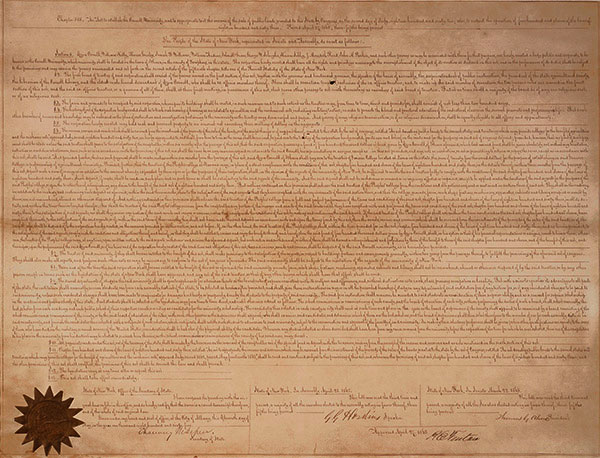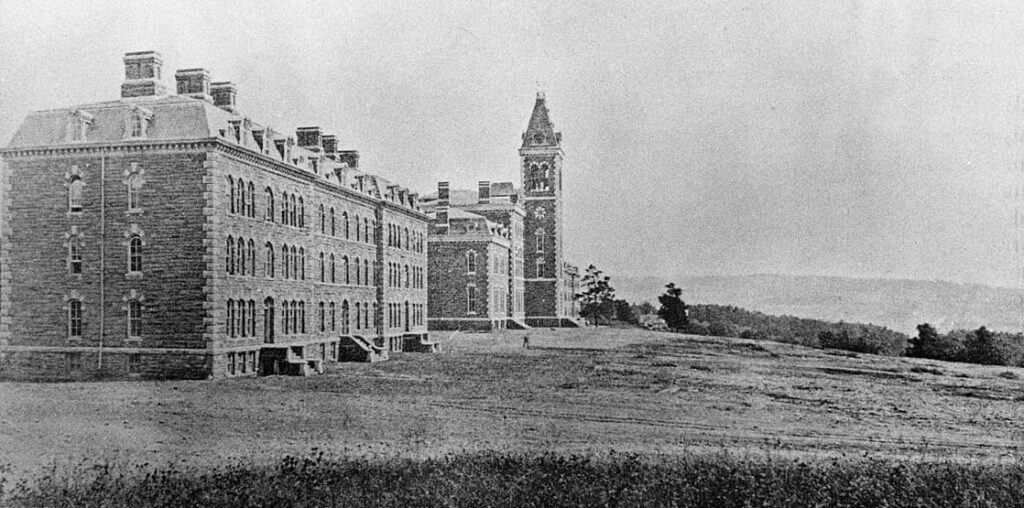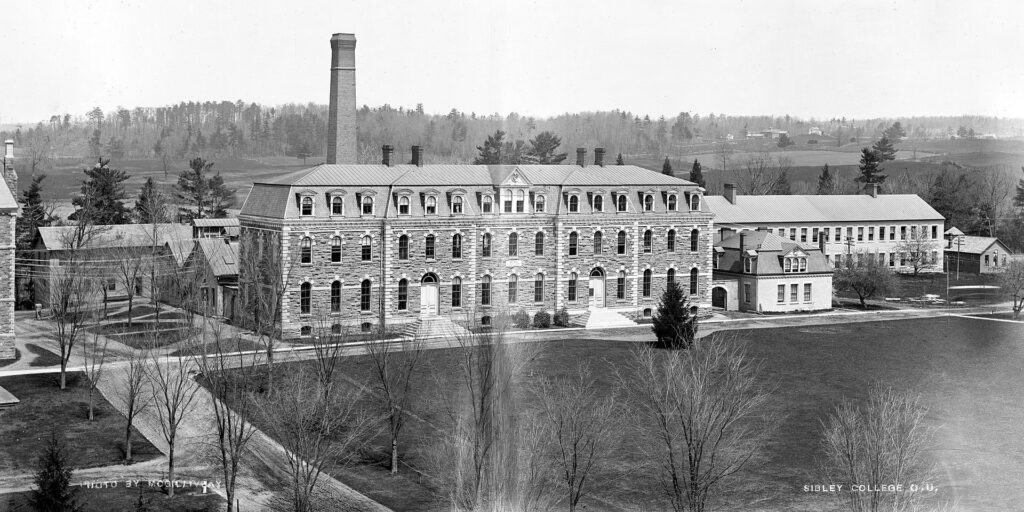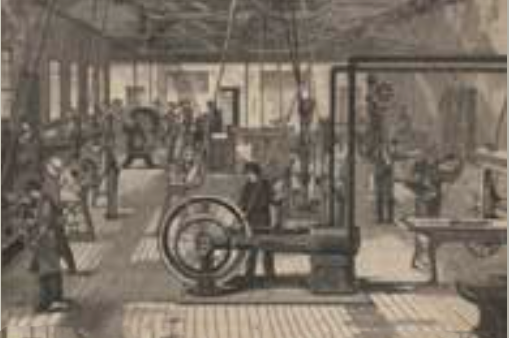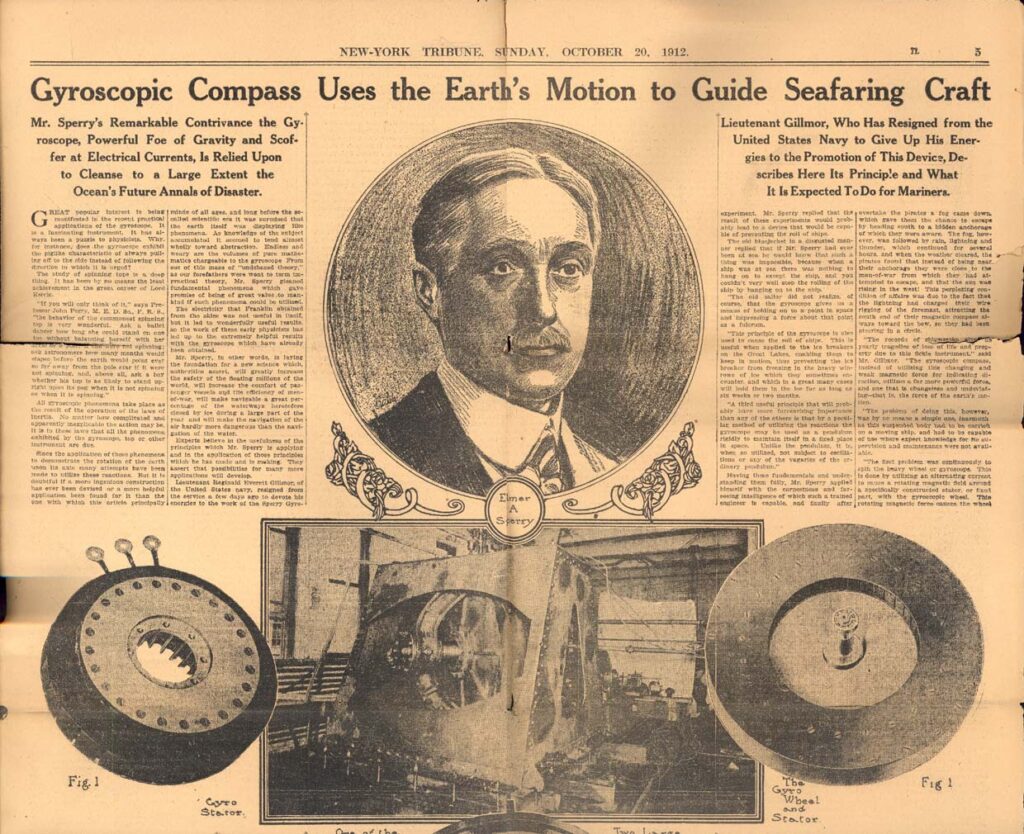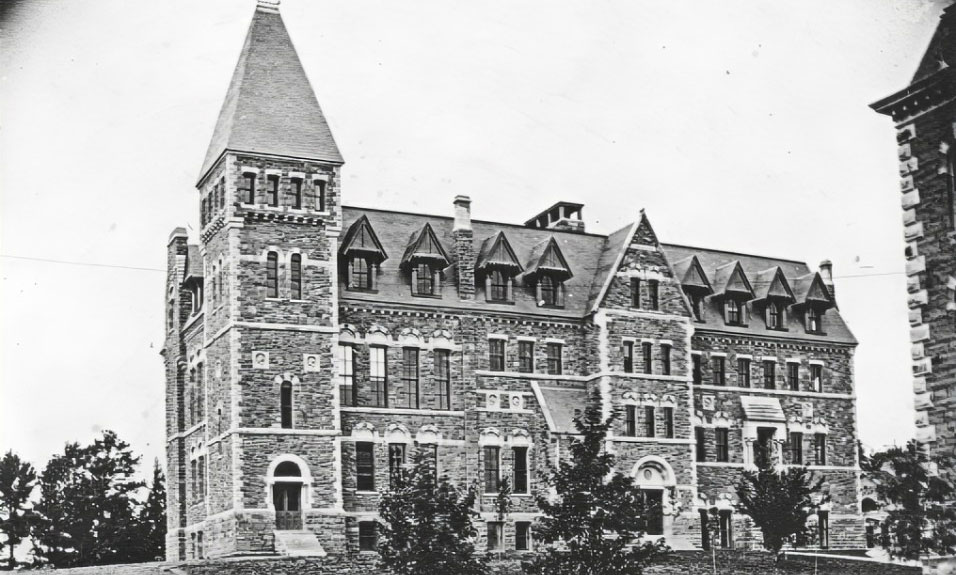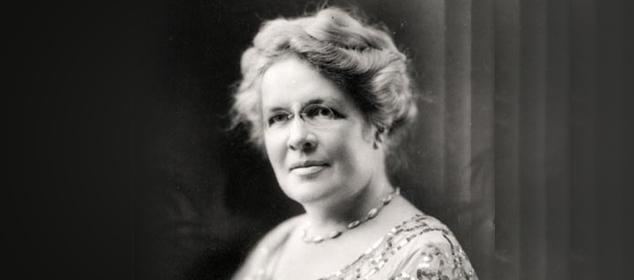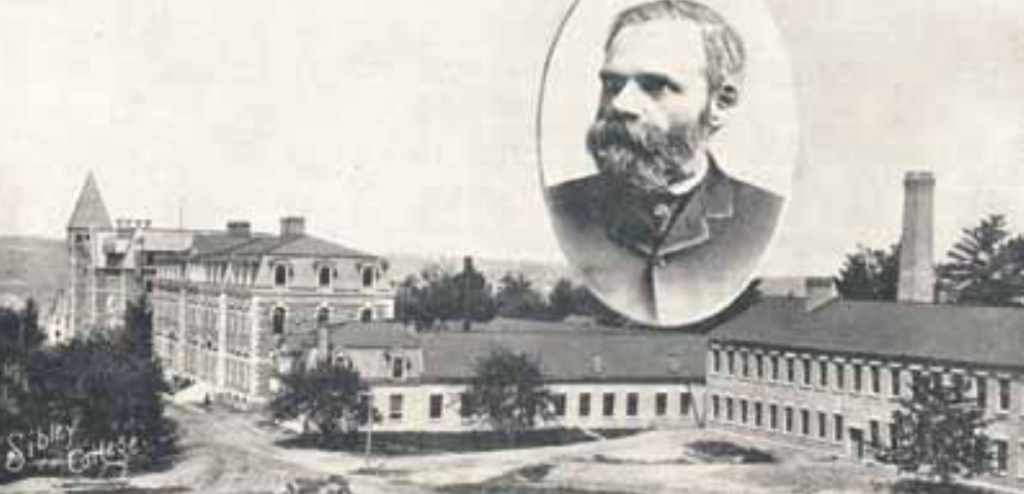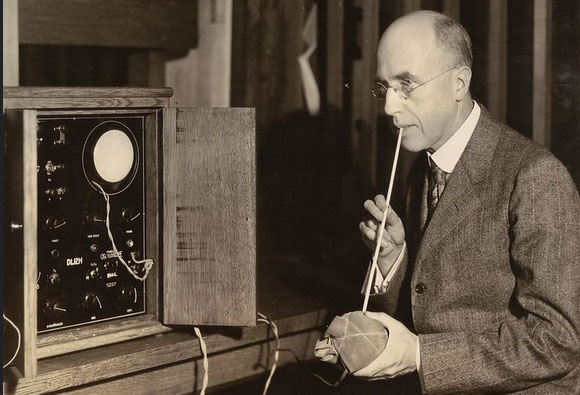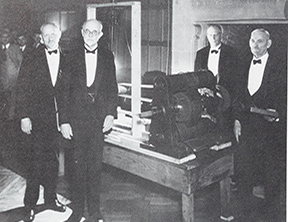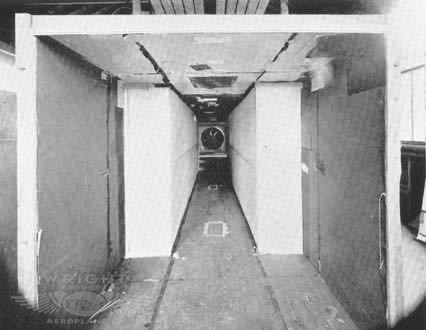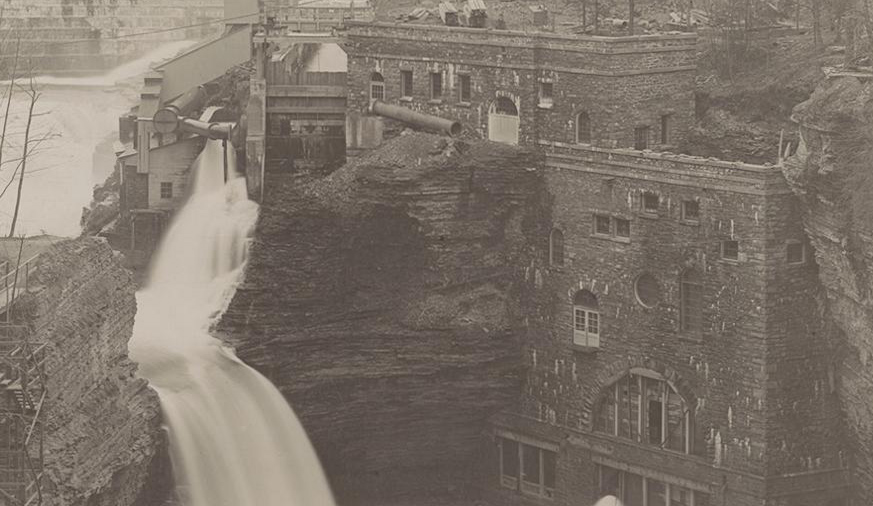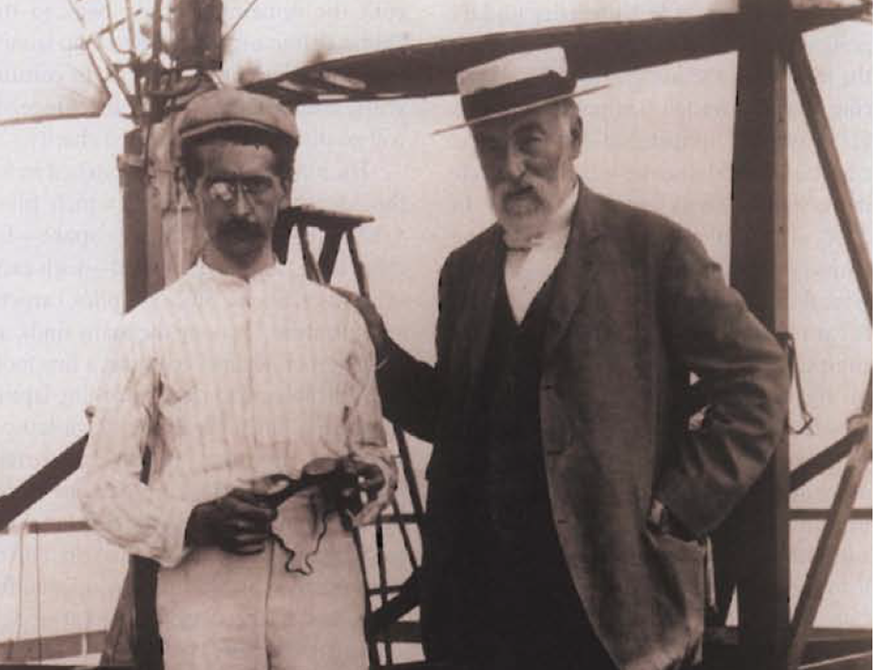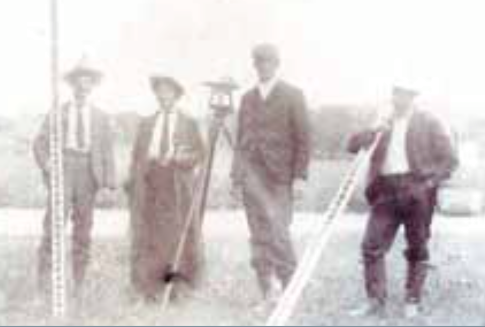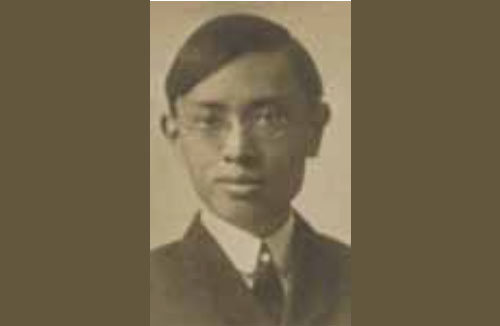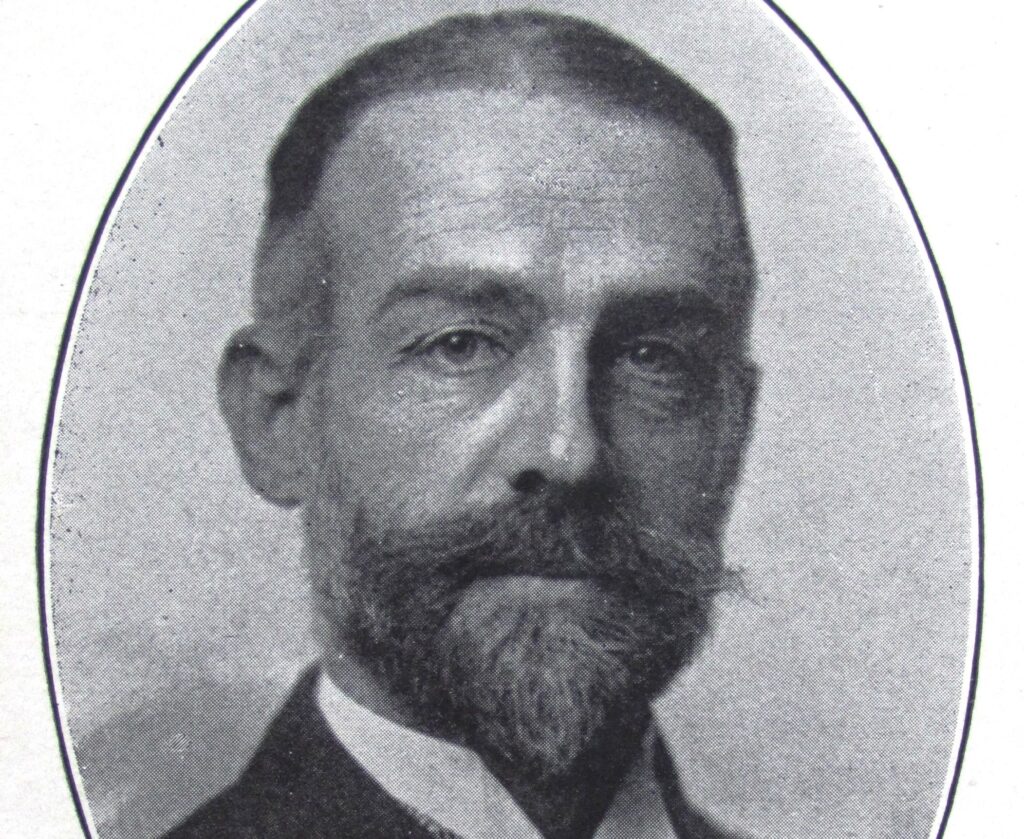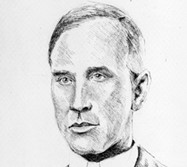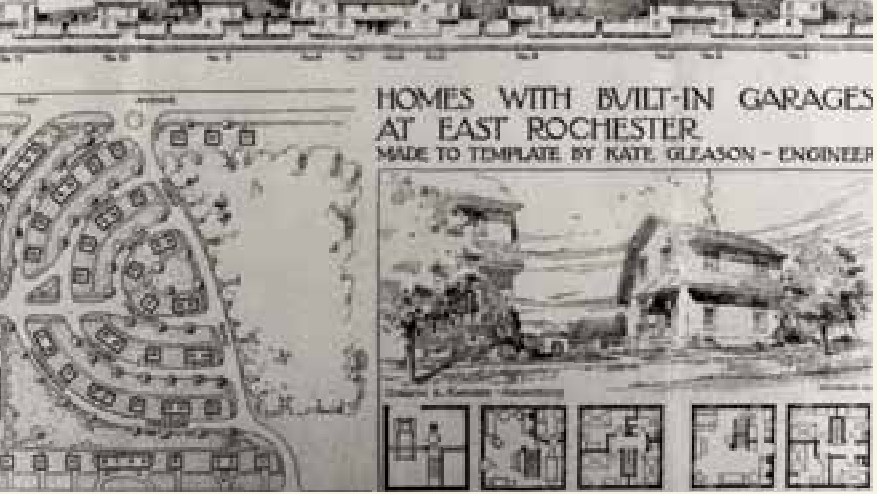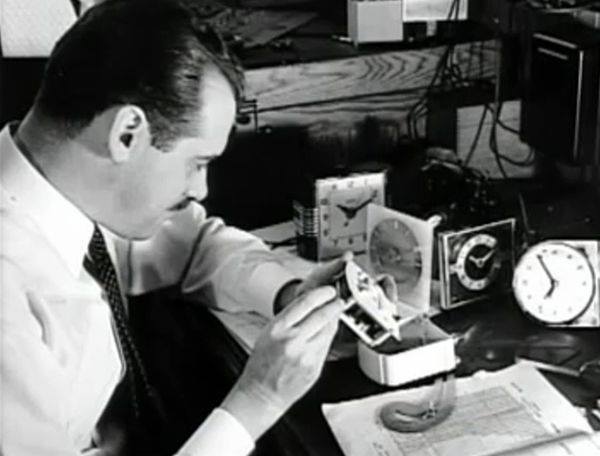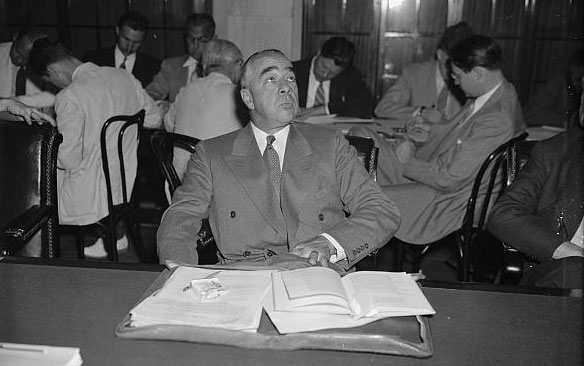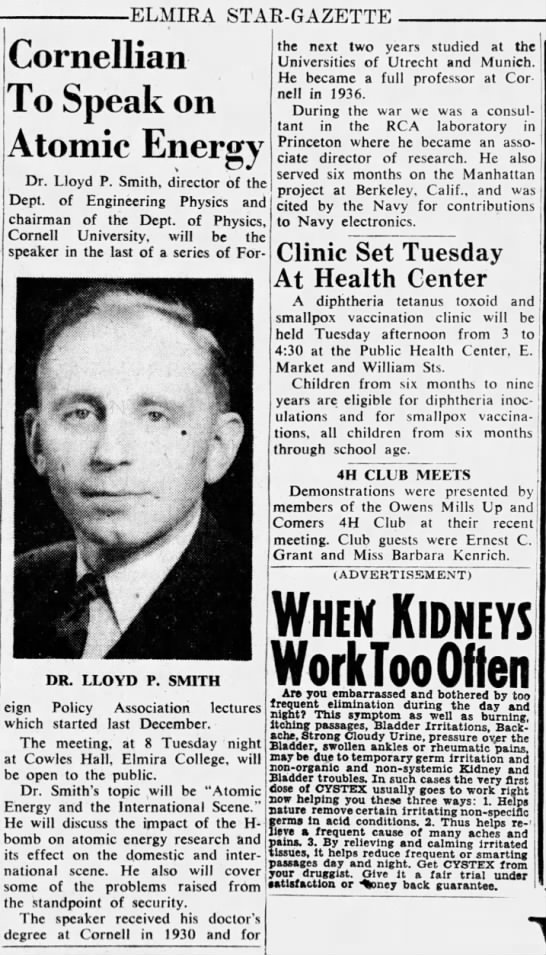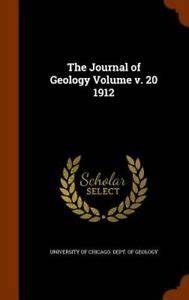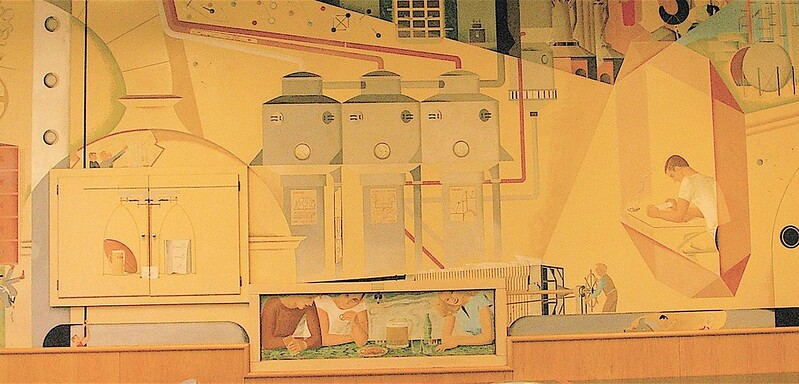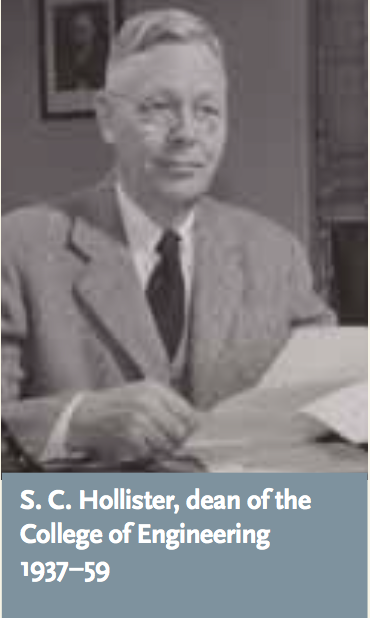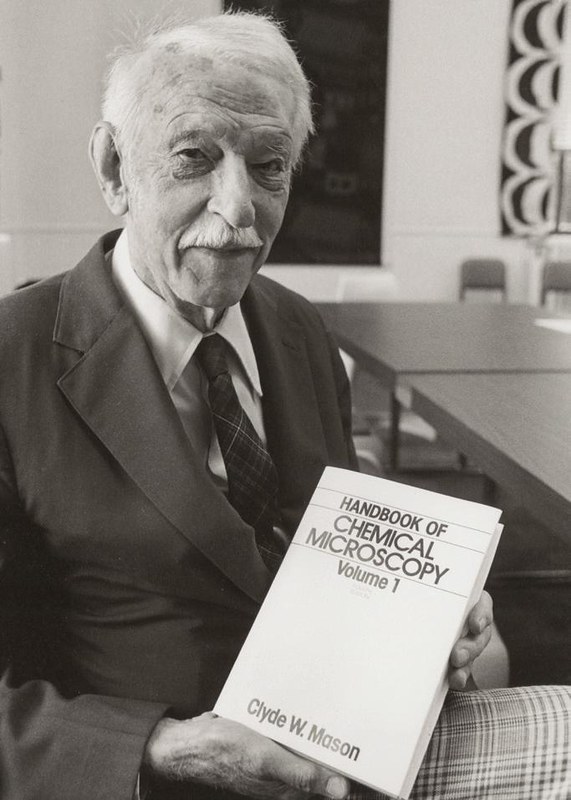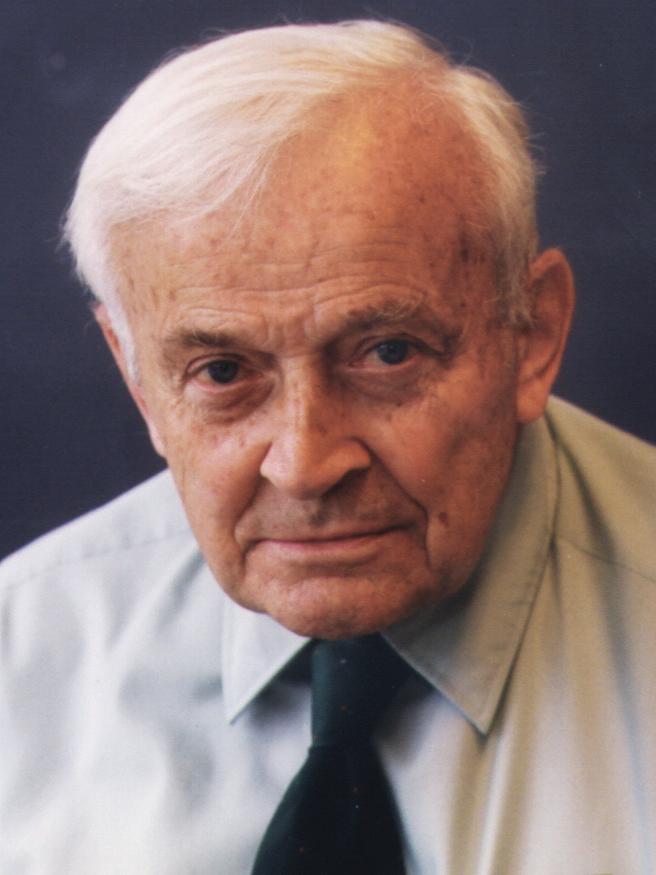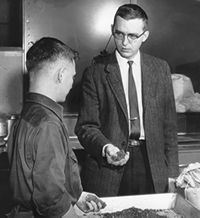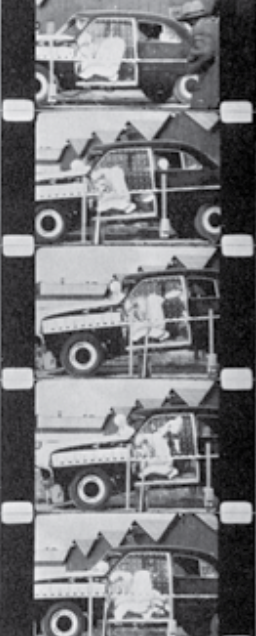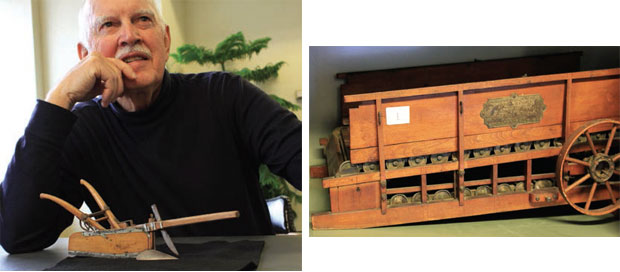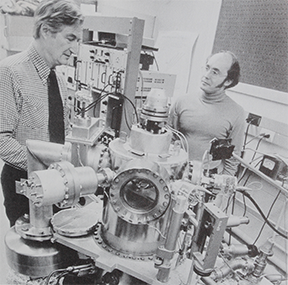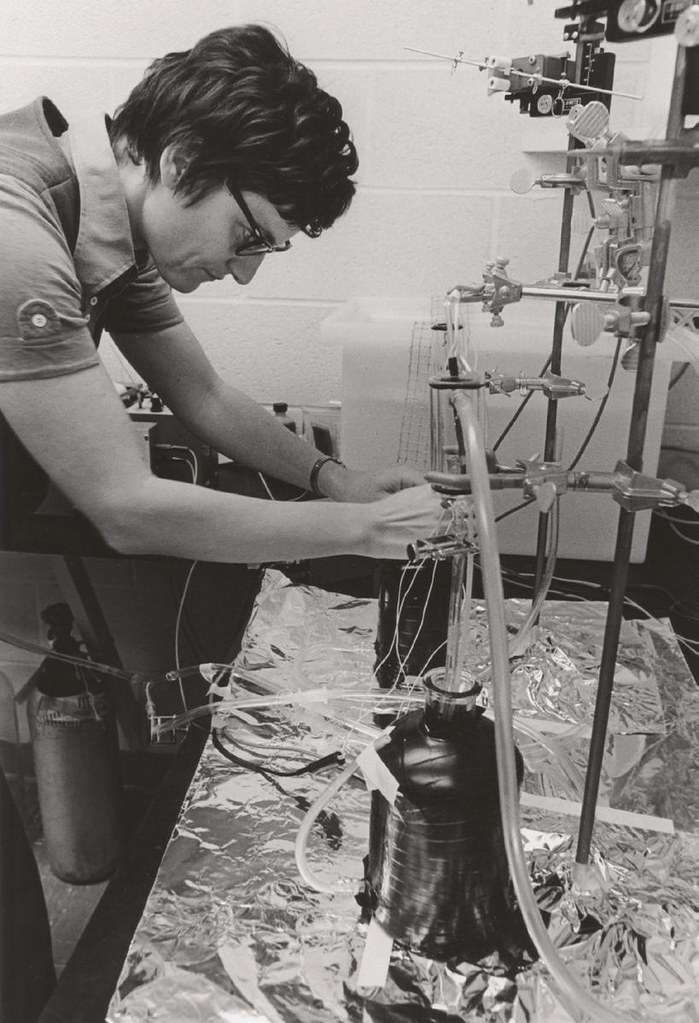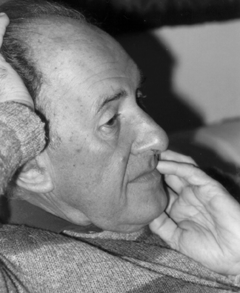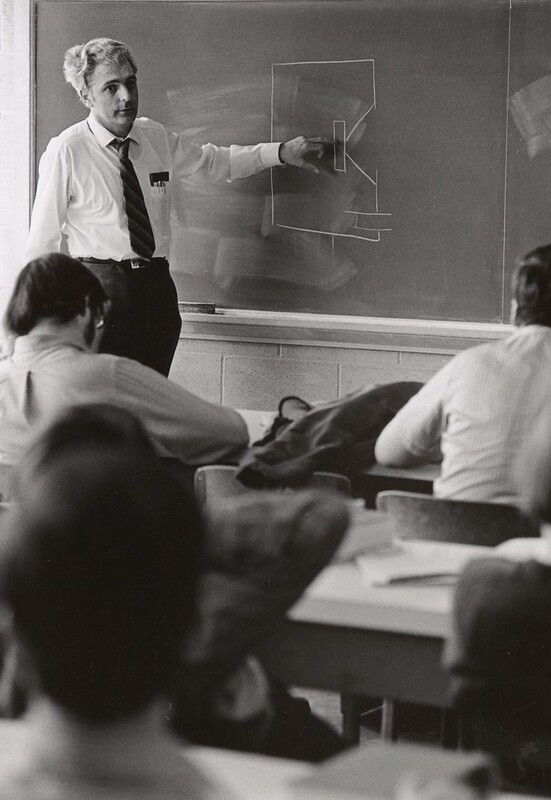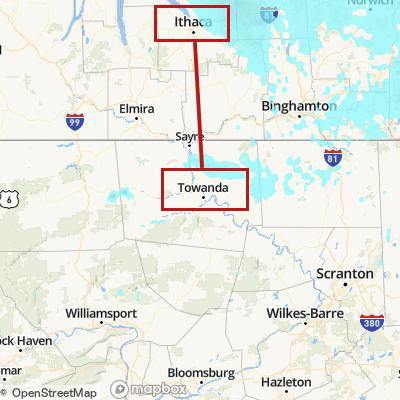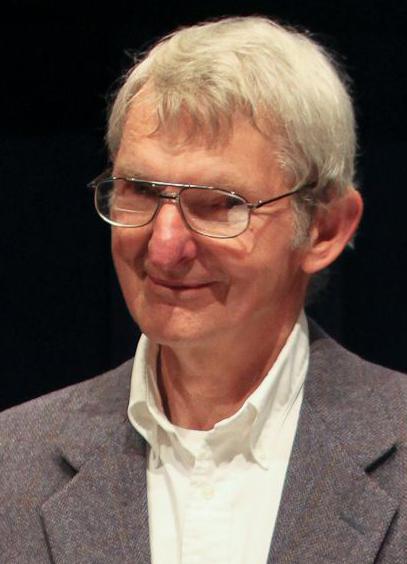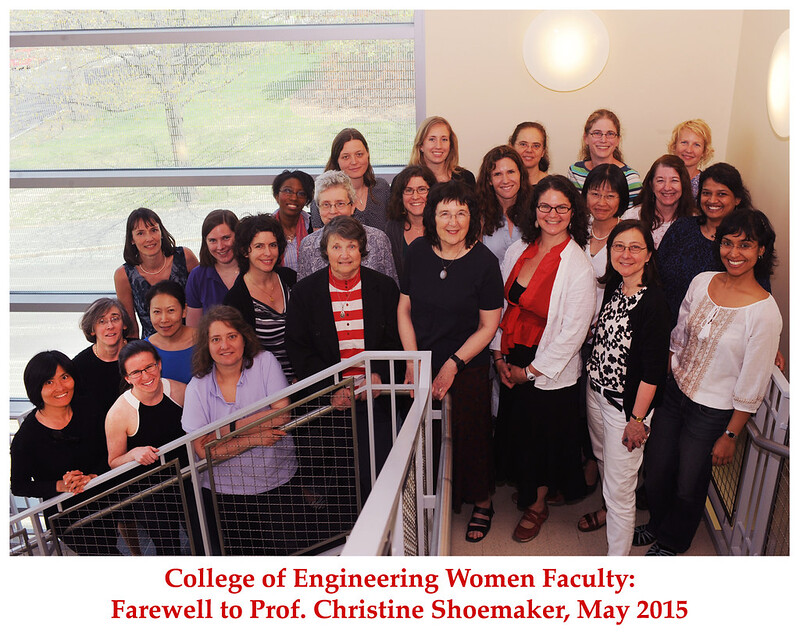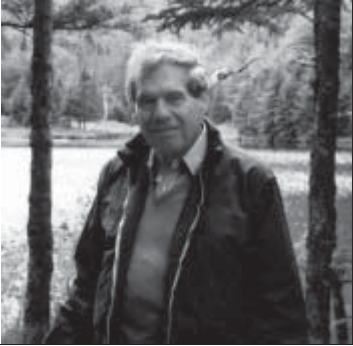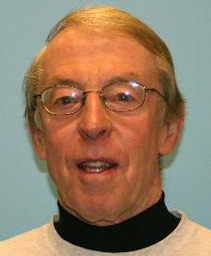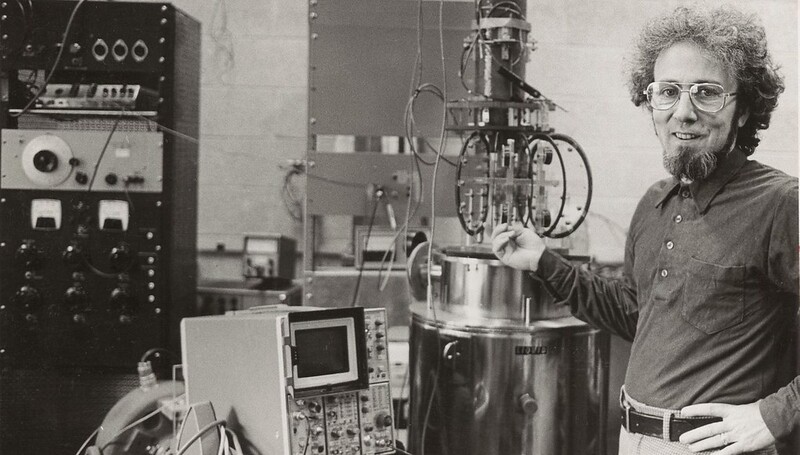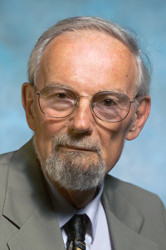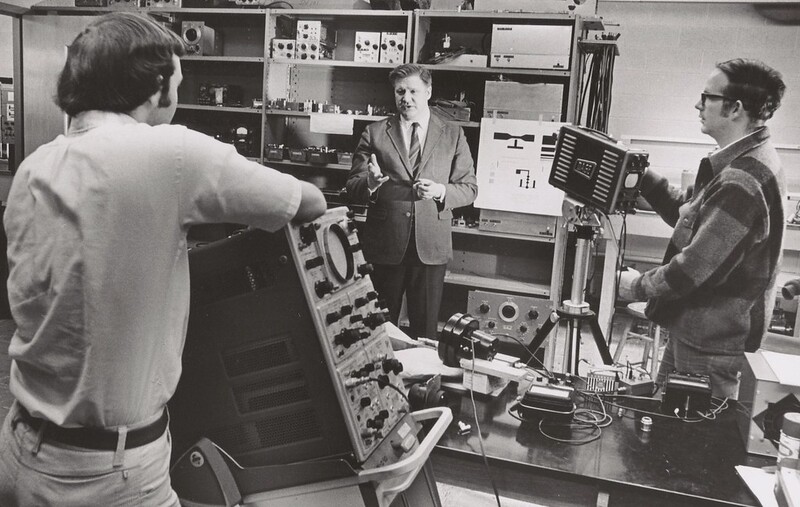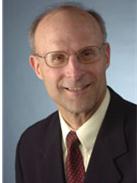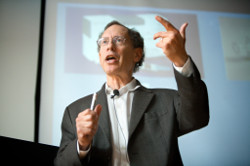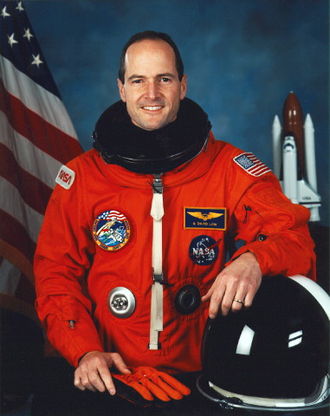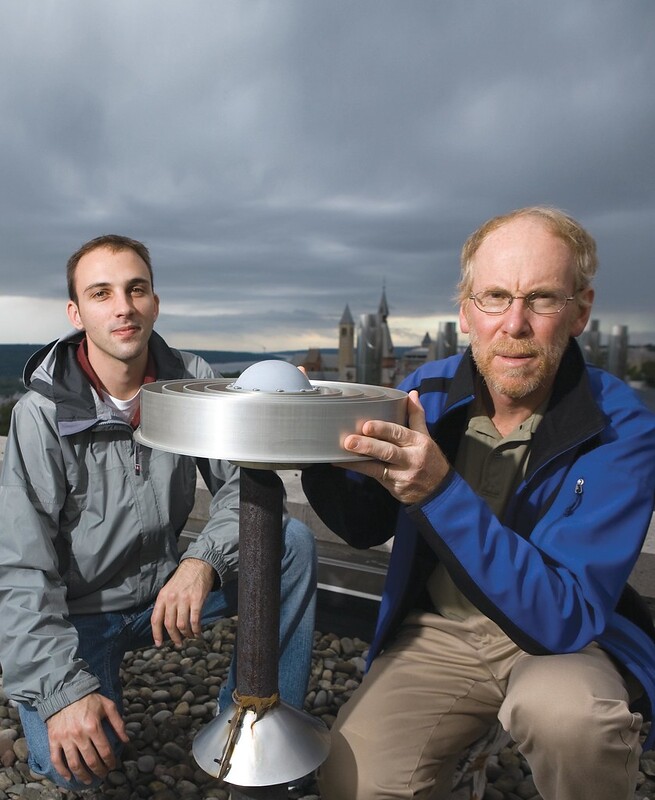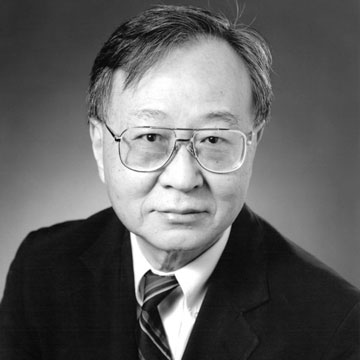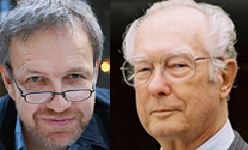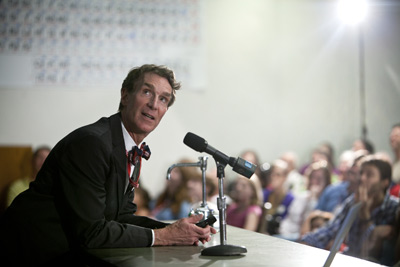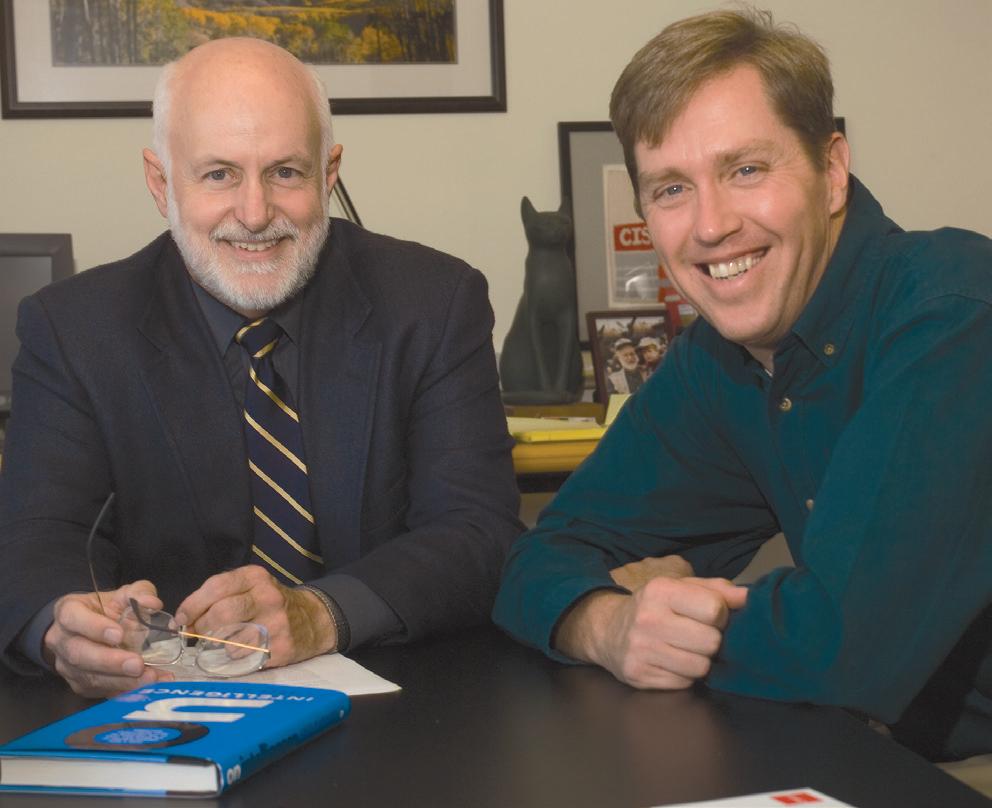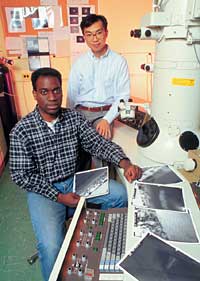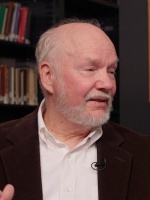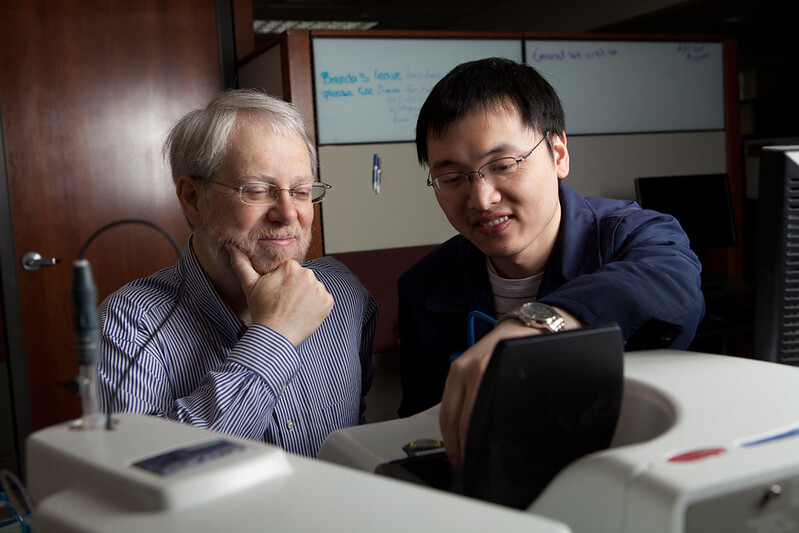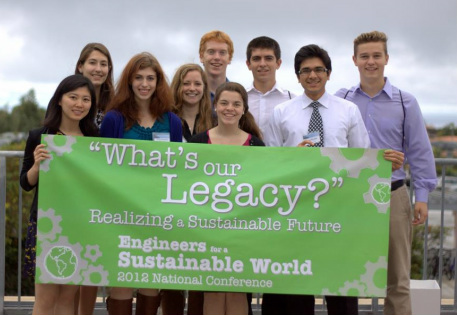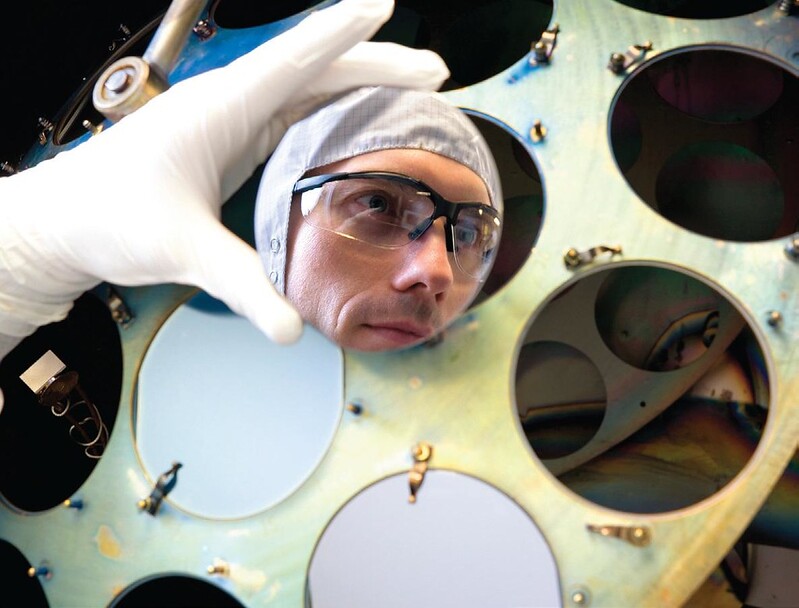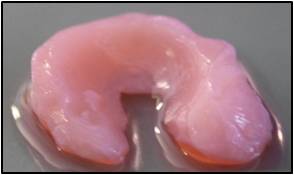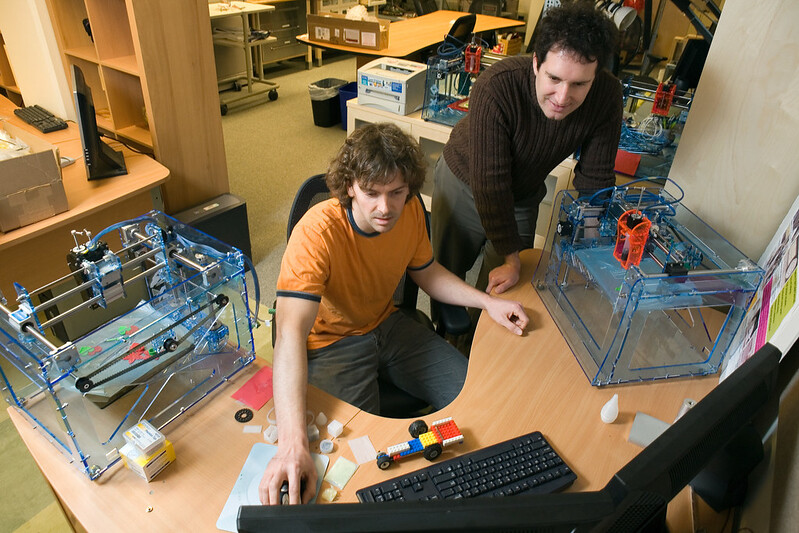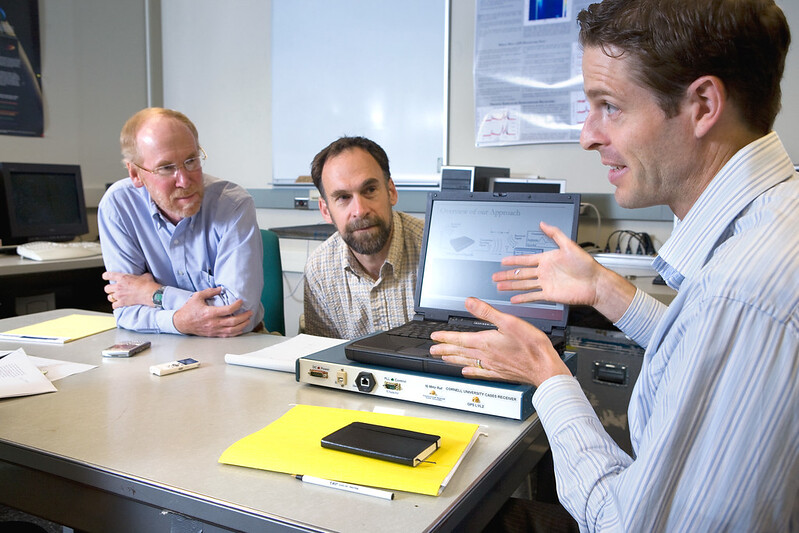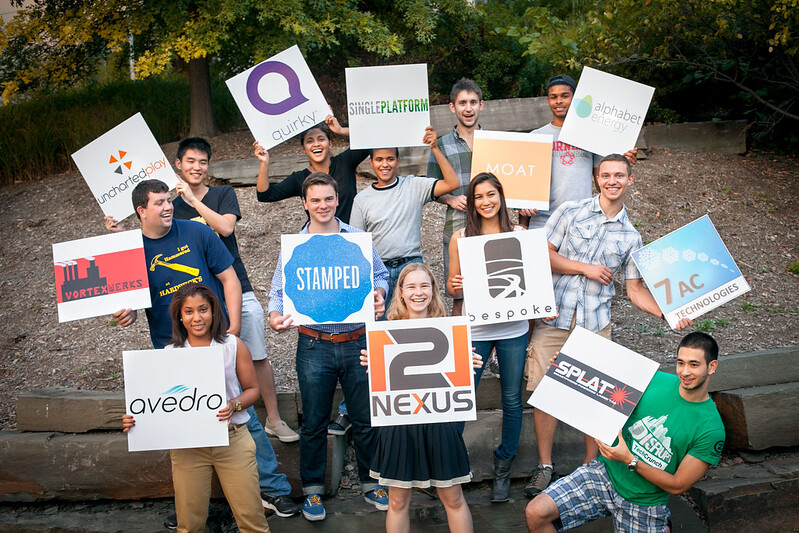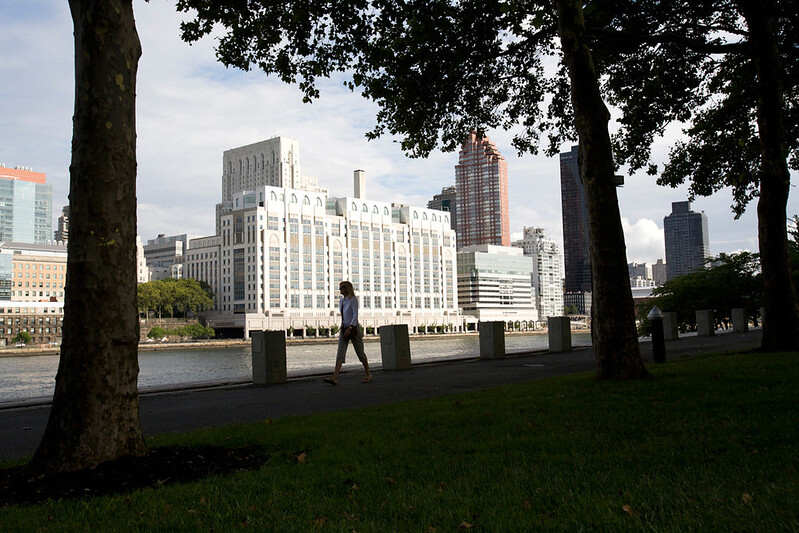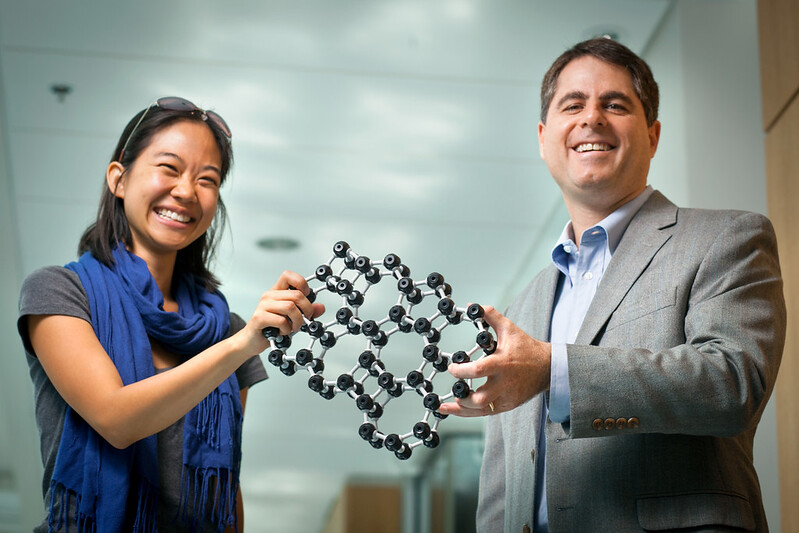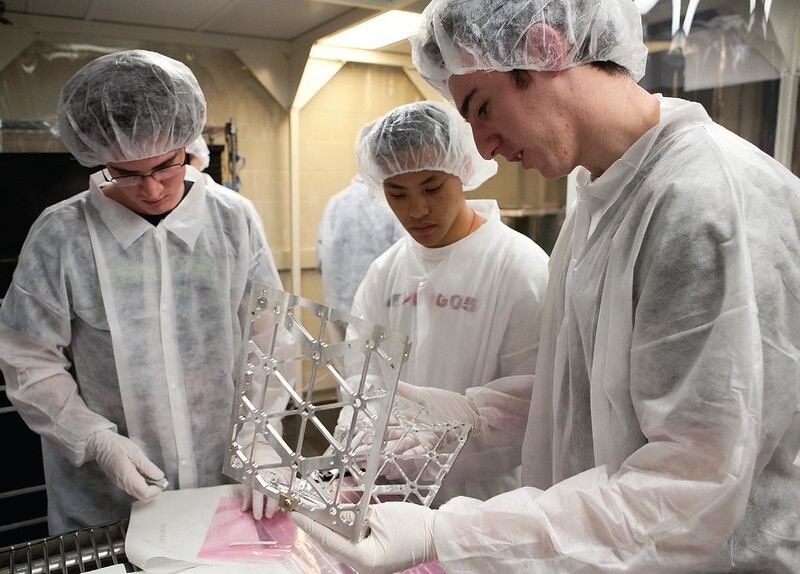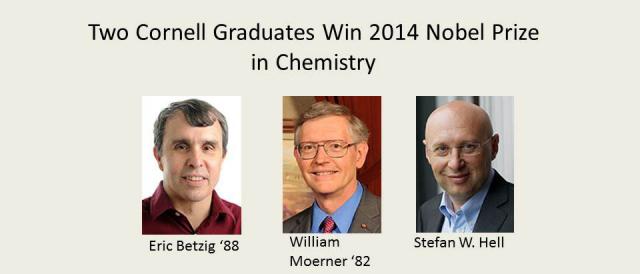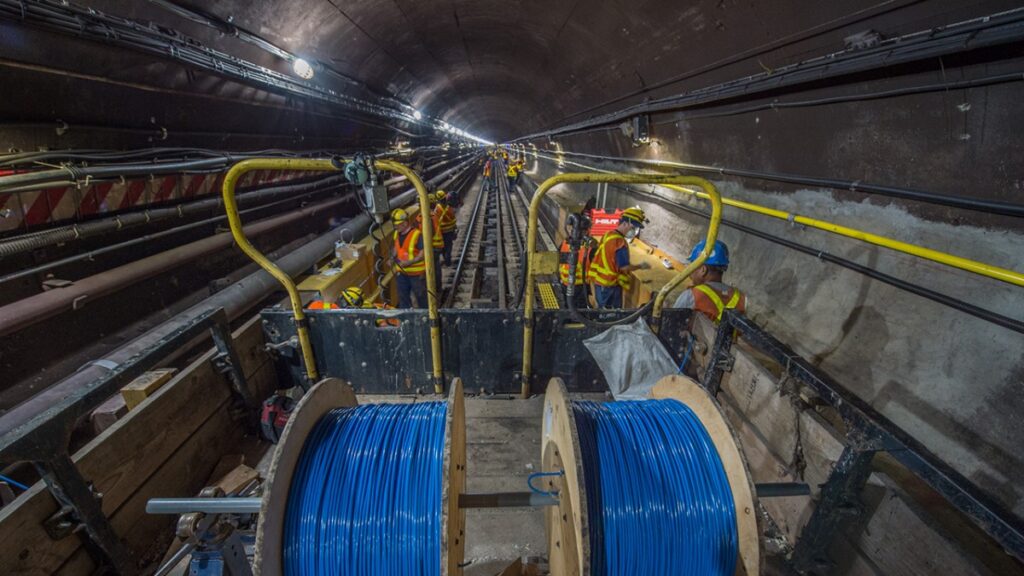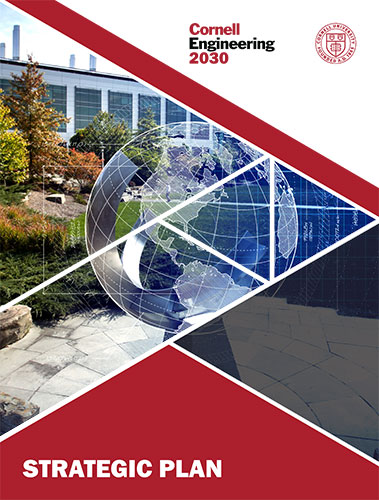Home » Our History
Our History
Our History

Cornell University established
Ezra Cornell and Andrew Dickson White win passage of the bill that charters Cornell University as the land-grant educational institution for New York, establishing the university.
Cornell University opens
At the official dedication of Cornell University and the inauguration of Andrew Dickson White as its first president, Ezra Cornell says, “I would found an institution where any person can find instruction in any study.”
Sibley funds creation of engineering college
Hiram Sibley, one of the 10 incorporators of Cornell, provides funds to house and support the Sibley College of Mechanical Engineering and Mechanic Arts.
First micrometer caliper for toolmaking
John Sweet, one of the first professors to ever teach engineering courses at Cornell, in 1873 built the first micrometer caliper for making tools in the United States. He also invented a nail-making machine that made the hand production of nails obsolete
Advancements in navigation and stabilization devices
Elmer Sperry, a Cornell engineering student from 1878 to 1879, invented many navigation and stabilization devices for ships and airplanes. His compasses and stabilizers were adopted by the US Navy and used in both world wars. They all used gyroscopes.
First electrical engineering course of study
One of the first courses of study in electrical engineering in the world was introduced at Cornell. In 1889, Cornell established an electrical engineering department which was then incorporated into the College of Engineering
First woman studies engineering at Cornell
Kate Gleason was the first woman to study engineering at Cornell. She left the engineering program after two years to work for her family’s business. She was later known as the “First Lady of Gearing” and perfected a technique for making beveled gears.
Thurston Advances Machine Technology
Robert Thurston, the first director of the Sibley College of Engineering in 1885, held two patents: one an autographic recording testing machine for material in torsion and the other a machine for testing lubricants. In 1875, he also developed the three-coordinate solid diagram for testing..Read More
Cornell awards nations first doctorates in IE and EE
In the late 1800s, Cornell Engineering awarded the nation’s first doctorates in Industrial Engineering and electrical engineering
Bedell invents an electric elevator
An electric elevator was invented in 1891 by Frederick Bedell (Physics, Ph.D., 1892) while he was still a grad student. His invention was an improvement over the hydraulic elevators that couldn’t reach the upper floors of New York City’s rising skyline. Bedell was later appointed..Read More
First physics-only journal founded
Physical Review, America’s first physics-only scientific journal, was founded at Cornell in 1893. It was founded by faculty member, Edward L. Nichols, (Physics, 1875), who edited it with the help of two of his colleagues, Ernest Merritt (Physics, M.S., 1886) and Frederick Bedell (Physics, Ph.D.,..Read More
First significant wind tunnel built
Albert F. Zahm, (Engineering, M.E., 1892) an early aeronautical experimenter and a chief of the Aeronautical Division of the U.S. Library of Congress built America’s first significant wind tunnel and helped organize the first international conference on aeronautics in 1893
Hydraulic research pioneers
Two graduate students Ernest Schoder (Ph.D., 1902) and August Saph (Ph.D., 1902) working in the Hydraulics Laboratory authored what was to become one of the classic studies in hydraulic experimentation. Their precise measurements on frictional resistance to the flow of water in pipes served as..Read More
Early aviation gasoline engine invented
Charles Manly (M.S.,1898) invented and built the first gasoline engine used for aviation. He also piloted an early experimental aircraft called the Great Aerodrome, built in collaboration with the secretary of the Smithsonian Institution (Samuel Langley), but the early experiments were not successful and Manly..Read More
Cornell graduates first female engineer
Nora Stanton Blatch Barney became the first woman to graduate from Cornell with an engineering degree in 1905. The daughter and granddaughter of suffragists, she studied civil engineering, and her groundbreaking career included working for the New York Public Service Commission as an assistant engineer..Read More
Early Chinese grad behind China’s railway
Thomas Sze, 1905, was one of Cornell’s earliest Chinese graduates, earning a B.S. in Mechanical Engineering. As a proud alum he went on to become a driving force behind the building of China’s national railway system (1909-1910), helping to influence the direction of a nation.
Forerunner of NASA formed
William Durand, a mechanical engineering professor from 1891 to 1904, was instrumental in forming the National Advisory Committee for Aeronautics (NACA) in 1915, which was the forerunner of NASA. Durand helped to plan the committee’s first laboratory at Langley Field.
Cornell football star succeeds on and off the field
Raymond Donald Starbuck (Civil Engineering, B.A., 1900) a famed Cornell football player. He was the fullback on the varsity football team in 1899 and 1900. He was captain of the football team in 1899 and 1900 and was selected as an All-American in 1900. In..Read More
First woman elected to American Society of Mechanical Engineers
Kate Gleason, who in 1884 was the first woman admitted to study engineering at Cornell, was in 1918 the first woman elected to the American Society of Mechanical Engineers. She also designed low-cost housing in Rochester using a concrete-pouring process that she invented.
Cornell grad changes time
The first synchronous electric clock (Hammond Clock) was created in 1920 by Laurens Hammond (Mechanical Engineering, 1916). Hammond also convinced power station engineers to use a 60-cycle as a standard for electric current. This allowed his electric clock to keep time based on oscillations in..Read More
College of Engineering established
A unified College of Engineering combined mechanical and civil engineering, which had been taught since the university’s first day of classes in 1868.
Pew advances technology and public policy
The namesake of the Pew Engineering Quad, Joseph N. Pew, Jr. (Mechanical Engineering, B.S., 1908) and later Vice President of Sun Oil Company developed in 1926 a gyroscopic instrument with a high-speed camera and timing device for preventing the drilling of crooked holes in oil..Read More
Amplifying direct currents
The FP-54 Pliotron electrometer was created by Lloyd P. Smith during his doctorate studies at Cornell in the late 1920s. This device was capable of amplifying direct currents as small as 10(-17) amps. Smith would later become the first director of Cornell’s Department of Engineering..Read More
Early groundwork for shale gas exploration
Pearl Gertrude Sheldon’s (A.B., 1908, M.A. 1909, Earth and Atmospheric Sciences, Ph.D., 1911) early research into shale fractures in the 1920s laid the groundwork for much of the North American shale gas exploration. Sheldon, a structural geology student spent several years afoot in the region..Read More
A smoother landing
First retractable landing gear for military planes was developed in 1932 by Leroy Grumman, (Mechanical Engineering, 1916). Designed at the request of the US Navy to replace hand-cranked landing gearing, it was first installed on the Grumman FF-1 biplane fight
Hammond organ invented
If you’ve been watching the Stanley Cup or baseball lately, chances are you’ve heard a direct descendant of Laurens Hammond’s 1934 invention – the electric organ. Hammond, ’16, created the inexpensive alternative to pipe organs that immediately found a home in churches, ballparks, and ice..Read More
First off-shore seismic reflection profile leads to petroleum exploration
Sidney Kaufman (1930, AB; Physics, 1934, Ph.D.) collected the first off-shore seismic reflection profile. As chief of a water seismic crew that normally operated in bays, marshes, inlets and lagoons, Kaufman in 1937 found a rock formation that extended from a bay near Corpus Christi..Read More
Olin opens as first engineering building
Olin Hall of Chemical Engineering was opened in 1942. Named after Franklin W. Olin (Civil Engineerings, B.S., 1886), it was the first building of the current Engineering Campus
Professor creates American Iron and Steel Standards and then American Concrete Standards
An expanding market for thin steel structures (1930’s) created a demand for rational design standards. Dean Solomon Cady Hollister obtained support from industry to conduct required research. George Winter (Pd.D. CEE 1940) and he joined the faculty of the School of Civil Engineering immediately and..Read More
Basis for modern materials research instruction
Clyde S. Mason (Ph.D. 1924), a professor from 1933 to 1966 in Chemical Engineering, developed the idea that properties of materials are related to and controlled by their structure. He related a microstructural approach that became the basis for modern instruction and research into materials
Use of x-rays as a byproduct
Assistant Professor Paul Hartman (Physics, Ph.D., 1938) was one of the first to investigate the use of X-rays generated as a byproduct of high-energy electron accelerators. This discovery goes on to inform the X-ray diffraction studies at facilities such as Cornell’s High-Energy Synchrotron Source (CHESS)
Cornell Local Roads Program established
James W. Spencer (Civil Engineering, B.S., 1949, M.S. 1951 ) became the first leader of the Cornell Local Roads Program (CLPR). Established after WW II, the program provided comprehensive applied research and extension support to county and town highway superintendents. CLRP has hosted “Highway School”..Read More
Safety with the three-point seat belt
First modern three-point seat belt invented in 1955 by Hugh DeHaven, of the Cornell Aeronautical Laboratory. This invention has saved millions of lives and DeHaven’s research into crash survival pioneered safety studies and helped shaped the modern automobile industry. “…people knew more about protecting eggs..Read More
Tractor rollover protection rolled out
Gerald Rehkugler, a faculty member since 1958 and Professor Emeritus of Biological and Environmental Engineering, developed a rollover-protection system for tractors that have become a standard feature to all tractors. He is also actively involved in a movement to preserve and display the University’s collection..Read More
Birth and evolution of surface science
The research by Thor Rhodin, a professor from 1958 to 1991 in Applied and Engineering Physics, was responsible for the birth and evolution of surface science, beginning with his research on surface sensitivity using auger electron spectroscopy. He played a major role in shaping the..Read More
Advancements in learning about the brain
The technique for detecting radiologic decay in tagged molecules called quantitative electron-microscopic autoradiography was developed by Miriam Salpeter during her postdoctoral research in the Department of Applied and Engineering Physics in 1961 to 1967. Developed with her husband, Cornell astrophysicist Edwin Salpeter, and Luis Bachmann,..Read More
Precursor to early search engines developed
Gerry Salton, professor and co-founder of the department of Computer Science at Cornell, developed the SMART information retrieval system in the early 1960s, which is the precursor to modern search engines. Salton was perhaps the leading computer scientist working in the field of information retrieval..Read More
Moog changes future of music
The moog synthesizer was patented in the mid-1960s by Robert Moog, (Applied and Engineering Physics, Ph.D., 1965). This invention was responsible for changing the landscape of popular music and ushering in the new genre of electronic music.
Distance learning begins
In 1966, the first Blackboard-by-Wire distance learning class was taught to 14 Cornell engineering students and 10 engineers in Towanda, Pennsylvania
Engineer pioneers software components
Unix pipelines and software componentry were developed by Douglas McIlroy (Applied and Engineering Physics, B.S., 1954). His pioneering work in component-based software engineering was developed when he was head of the research department at Bell Laboratories. His seminal work on software componentization makes him a..Read More
Focus on groundwater contamination in development
Professor Christine Shoemaker initiated and led the United National Environment Program/Scientific Committee on Problems of the Environment. The group focuses on groundwater contamination in development. She was also one of the first women engineering department chairs at an American university. Here, she is pictured in..Read More
“Hart’s Equations” incorporate time dependence
Edward W. Hart, a faculty member of both Materials Science and Theoretical and Applied Mechanics from 1975 to 1988, developed “Hart’s Equations,” which were the first to incorporate time dependence into the analysis of deformation processes in a materials-specific way. His formulation is still the..Read More
Graphene technology advancements
In 1974, Jack Blakely, professor, and his students in Materials Science and Engineering were the first in the world to synthesize a single layer of graphene (a very thin, nearly transparent sheet, one atom thick) and determine its structure. The method they developed is the..Read More
“Moon Lab” begins mulitple decades of nonlinear and chaotic dynamics
F.C. Moon has made contributions to the field of nonlinear and chaotic dynamics of mechanical systems. He was one of the first in his field to develop new experimental tools of analysis in nonlinear vibrations based on Poincare maps and fractal measures of chaos. His..Read More
PMU tecnology diminishes frequency of blackouts
Jim S. Thorp (Ph.D., 1962; M.S., 1961; B.S., 1959, electrical engineering) co-invented (with Arun Phadke of Virginia Tech) the phasor measurement unit (PMU) for which he was elected to the National Association of Engineering and won the Benjamin Franklin Medal in Electrical Enginering (also won..Read More
Communication advancements are seeded
Lester Eastman, (Electrical Engineering, Ph.D., 1957; M.S., 1955; B.S., 1953) contributed to the pioneering advances in communications technology resulting from the development of high-speed and high-frequency gallium arsenide devices. His research now permeates cell phone technology and radar and satellite communication applications
Video endoscopy advancements
Richard W. Newman, (Mechanical Engineering, B.S., 1968) developed the first video endoscope. After a 40-year career designing medical diagnostic devices for Welch Allyn, Inc. Newman made significant contributions to the fields of flexible video endoscopy, glaucoma, and Alzheimer’s disease
Prolific researcher’s discoveries save lives
Cornell graduate and Charles Stark Draper Prize winner Robert Langer (Chemical Engineering, B.S., 1970) developed a porous polymer drug delivery system to treat certain tumors. He also developed implantable microchips that could release drugs on command. In 1988, he discovered the use of polymer-based scaffolds..Read More
Alum was astronaut on three space flights
George David Low, (Mechanical Engineering, B.S., 1980), was an astronaut of three space flights, logging more than 714 hours in space, including nearly six hours on a spacewalk. On his first flight into space, an 11-day mission aboard the space shuttle Columbia, Low carried with..Read More
Technology heads into space
The research of Paul Kintner, professor of Electrical and Computer Engineering, has made significant contributions to the understanding of space environments. His plasma wave interferometer was developed in 1986 and launched into space with the Viking satellite. He was head of the Global Positioning Systems..Read More
Invention Increases Microprocessor Speed
Hwa C. Torng (M.S. 1958, Ph.D. 1960), Patent for the first Intel Chip. The patent in question— US patent No. 4,807,115, “Instruction issuing mechanism for processors with multiple functional units”— was granted in 1989 to Cornell Research Foundation, covering a technique invented by Hwa C...Read More
Multiphoton microscopy developed
Multiphoton microscopy was developed in 1990 between Winfried Denk (Physics, Ph.D., 1989) and Watt Webb, Professor of Applied and Engineering Physics. This innovation was first used in biological studies, where it produced high-resolution, three-dimensional images without damaging living tissues
“Bill Nye the Science Guy” begins its run
“Bill Nye the Science Guy” (Mechanical Engineering, B.S., 1977) popularized science for children (and their parents) with a PBS kids show from 1993-1998. Still enjoying widespread popularity today, Nye remains a staunch advocate for science education and appears frequently on television and radio programs
Palm pilot invented
Jeffrey C. Hawkins (Electrical Engineering, B.S., 1979) invented the Palm Pilot, one of the first successful handheld personal digital assistant devices. The Palm Pilot’s form and function impacted the design of future smartphones. He is pictured here with Professor Robert Constable.
Semiconductor work revolutionizes industry
In 1997, The New York Times hailed Cornell assistant professor of Electrical Engineering Yu-Hwa Lo’s work with the potential to “revolutionize the industry.” Dr. Lu’s patent for a compliant universal substrate for growing pure, single crystals was seen as a major turning point in manufacturing..Read More
Electricity from manure
William Jewell, professor emeritus in the Department of Biological and Environmental Engineering, developed a nationally recognized initiative that employs animal manure in anarerobic digestion systems to produce electricity and heat on a farm
Epoxy holds computer components together
In 2000, Christopher Ober, a professor of Materials Science and Engineering, created Alpha-Terp, a thermoset epoxy used to hold computer components together. It melts at high temperatures, allowing components to be sorted and recycled when the computer’s life is over. This innovation has saved millions..Read More
Engineering leadership for sustainability
The first American headquarters and student chapter for Engineers for a Sustainable World was established in 2001 at Cornell Engineering. The organization aims to engage engineers in reducing poverty by improving environmental, social and economic sustainability worldwide
Duffield Hall completed
Duffield Hall, named for Cornell Engineering alumnus David Duffield ’62 Electrical Engineering, is one of the country’s most sophisticated research and teaching facilities for nanoscale science and engineering
First bio-printing of living tissue
The first bio-printing of living tissue was achieved by Prof. Hod Lipson from Mechanical and Prof. Larry Bonassar from Biomedical engineering. The researchers printed a meniscus which lived for three months in incubation. Consequently, the field of bio-printing is launched
Fab@Home project launches 3D printer revolution
The Fab@Home project launched at Cornell Engineering. Designed and produced by Mechanical and Aerospace Engineering students, this first fully open-source 3D printer in the US, helped launch the consumer 3D printing revolution. Hod Lipson and Evan Malone of the Cornell University Computational Synthesis Laboratory began..Read More
Hacking the hackers
Todd E. Humphreys, (Aerospace Engineering, Ph.D., 2007); Paul Kintner and Mark Psiaki, professors of Electrical and Computer Engineering; Brent Ledvina, (Electrical Engineering, Ph.D. 2004); demonstrated the first known GPS spoofing attack, where a hacker can fool a targeted GPS receiver to misestimating its position, time..Read More
Kessler Program for start-ups starts up
The Kessler Fellows Program at Cornell Engineering was founded in 2009. This innovative and one-of-a-kind program combines an engineering degree with deep exposure to start-up culture making graduates uniquely prepared to apply to skills to new opportunities and industries.
Cornell Tech is born
Cornell University was designated by New York City to build a sustainable campus on Roosevelt Island for graduate tech education. Cornell Tech (created under Dean Lance R. Collins) is an innovative, sustainable academic campus made up of a combination of state of the art academic..Read More
World’s thinnest sheet of glass
The world’s thinnest sheet of glass was created by David Muller, professor of Applied and Engineering Physics (M.S. 1994, Ph.D., 1996) and graduate student Pinshane Huang (M.S. 2012, Ph.D. 2014, Applied and Engineering Physics). This was the first time anyone was able to see the..Read More
Nanosatellite launched into space
The Cornell University Satellite, a nanosatellite designed and built by students, is launched into space. The Cornell University Satellite (CUSat) is a nanosatellite developed by Cornell University that launched on 29 September 2013. It used a new algorithm called Carrier-phase Differential GPS (CDGPS) to calibrate..Read More
Nobel Prize in Chemistry for optical microscopy
Eric Betzig (Applied and Engineering Physics, Ph.D., 1988; M.S., 1985) along with William E. Moerner, (Experimental Physics, Ph.D., 1982; M.S., 1978) were awarded the Nobel Prize in Chemistry in 2014 for their groundbreaking achievements in optical microscopy where the pathways of individual molecules can be..Read More
Cornell engineers get NYC L train back on track
Rehabilitation of the L train, the New York City subway line connecting the boroughs of Manhattan and Brooklyn, finished six months ahead of schedule and $100 million under budget thanks in part to Cornell engineers who drastically changed the project’s approach.
Cornell Engineering 2030 plan implemented
Dean Lynden Archer launches a 10-year strategic plan to establish Cornell Engineering as a center of excellence in innovating impactful solutions to the most difficult problems
